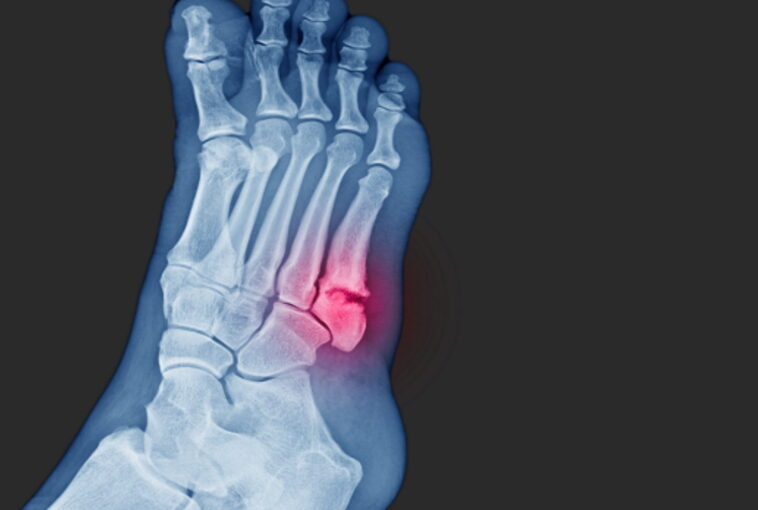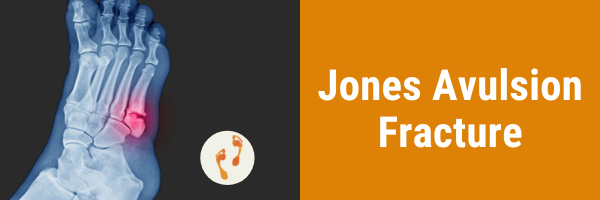An avulsion fracture occurs when part of the bone is broken off from the rest of the bone. The part of the bone that breaks off is attached to a tendon or ligament, and it is the strain and pull from this tendon or ligaments that causes the bone to fracture, as opposed to other cases where the tendon or ligament itself ruptures.
A Jones Fracture Is Felt On The Outside Of The Foot

A Jones avulsion fracture specifically occurs at your fifth metatarsal, the bone that runs from the midfoot to the base of the small (pinky) toe on the outside of the foot. If you run your fingers along the outside edge of your foot, you’ll be able to feel a bump around the midfoot called the styloid process. This bony bump is where the fracture occurs.
What makes a Jones fracture difficult to heal at times is that the region of the styloid process where the fracture occurs has a poorer blood supply than other areas of the foot, meaning that healing and repair can be lengthy. Helping the bone heal correctly is important to help prevent future discomfort and reduce the risk of reinjury.
What Are The Symptoms Of A Jones Avulsion Fracture?
The most common signs of an avulsion fracture of the fifth metatarsal include:
- Swelling along the outside of the foot
- Bruising along the outside of the foot extending into the toes
- Pain on the outside border of the foot that can radiate up the leg
- Difficulty walking or a limp
- Inability to wear shoes without significant pain
Who Is At Risk?
This type of fracture can occur to anyone, in any age group. Any activity that causes the foot to forcefully roll inwards is enough to lead to one of these fractures – the injury can happen as a simple result of simply stepping awkwardly off a curb, stepping into a hole, twisting your foot during sports activities, or falling off a step. This fracture is also seen alongside ankle sprains.
Some people are at a higher risk of sustaining a fracture like this, by overusing a muscle that runs down the outside of your leg and attaches to the styloid process called the peroneus brevis. When this muscle is tight and repetitively pulls at its attachment, the fracture is most likely to occur. This means that this type of fracture can sometimes happen to dancers, especially in ballet due to the time spent on the toes.
How Is An Avulsion Fracture Treated?
- RICE – at the first sign of pain, the most important step is to Rest, apply Ice to help reduce the swelling, use Compression if possible, and Elevate your foot
- Take Pain-Relief – non-steroidal anti-inflammatory medications (NSAIDs) like Neurofen can help with the swelling and pain
- See Your Podiatrist – we’ve described further on how we can help below, but seeing a podiatrist is essential with a suspected Jones fracture because they have a higher rate than other fractures of not healing, with up to 20% of fractures failing to heal conservatively. Working with a podiatrist maximises your chances for successful healing
- Surgery – in some cases, depending on the severity of your injury, surgery may be an option. If this is the case, we will refer you appropriately
- Recovery – Healing and return to activity can take anywhere between six weeks to four months, or longer if complications arise
Podiatrist Treatment
We recommend making an appointment to see your podiatrist as soon as possible if you suspect that you have a Jones fracture. As these fractures take longer to heal due to their location, effective treatment from the get-go is key to an optimal recovery. Depending on your symptoms, we may recommend:
- A moon boot or other walker
- Custom foot orthotics that alleviate pressure and pain away from the outside border of the foot and the fracture site
- Adjusting the shoes you wear daily to help best support your recovery
- Adjusting your regular activity plan. No physical therapy should be started until significant healing and repair has occurred
If the fifth metatarsal heals improperly, or fails to heal due to lack of support, we can refer you for a surgical procedure. Often, this is left as a last result due to the lengthy recovery time and a reduced chance for a satisfying result.
FAQs
What is the difference between a Jones avulsion fracture and other types of foot fractures?
A Jones avulsion fracture specifically refers to a fracture at the base of the fifth metatarsal bone, which is located on the outer side of the foot. It occurs due to excessive stress or pull on the tendon that attaches to the bone. Other foot fractures may involve different bones or locations within the foot.
Is surgery necessary to treat a Jones avulsion fracture?
In some cases, surgery may be necessary to treat a Jones avulsion fracture, particularly if the fracture is displaced or if conservative treatments have not been successful. Surgery typically involves realigning the bone fragments and stabilising them with screws, wires, or other fixation devices. However, not all Jones avulsion fractures require surgery, and non-surgical treatments should be tried first given the invasive nature of surgery.
How long does it take to recover from a Jones avulsion fracture?
The recovery time for a Jones avulsion fracture can vary depending on the severity of the fracture, the chosen treatment approach, and individual factors. Generally, it takes approximately 6 to 8 weeks for the bone to heal. However, full recovery and return to regular activities may take several months. It’s important to follow the guidance of your podiatrist and gradually increase activity levels as directed.
Are there any complications associated with a Jones avulsion fracture?
Yes, there can be potential complications associated with a Jones avulsion fracture. These may include delayed or non-union (when the fracture does not heal properly), malunion (when the bone heals in an improper alignment), avascular necrosis (loss of blood supply to the bone fragment), and chronic pain.
Can I bear weight on the affected foot with a Jones avulsion fracture?
The ability to bear weight on the affected foot with a Jones avulsion fracture depends on the severity of the fracture and the treatment approach. In some cases, weight-bearing may be restricted initially to allow for proper healing. Your podiatrist will provide specific instructions on weight-bearing limitations and gradually reintroduce weight-bearing activities as the fracture heals.
Are there any long-term effects or risks associated with a Jones avulsion fracture?
Some people may experience residual pain, weakness, instability, or a higher risk of future fractures in the same area. Adhering to proper rehabilitation, following preventive measures, and maintaining overall foot health can help minimise long-term effects and reduce the risk of recurrence.
How can I manage pain and swelling after a Jones avulsion fracture?
To manage pain and swelling after a Jones avulsion fracture, your podiatrist may recommend:
- Resting and elevating the affected foot to reduce swelling.
- Applying ice packs or cold therapy for 15-20 minutes at a time, several times a day.
- Taking over-the-counter pain relievers, as directed by your healthcare provider.
- Wearing a protective boot or cast to provide support and immobilisation.
When can I return to my regular activities or sports after a Jones avulsion fracture?
The timeline for returning to regular activities or sports after a Jones avulsion fracture depends on various factors, including the severity of the fracture, the chosen treatment approach, and individual healing rates. Your podiatrist will provide specific guidance on when you can gradually resume activities and sports.
What can I do to promote bone healing and overall recovery after a Jones avulsion fracture?
To promote bone healing and overall recovery after a Jones avulsion fracture, you can:
- Follow your podiatrist’s instructions regarding weight-bearing, immobilisation, and use of assistive devices.
- Attend scheduled follow-up appointments to monitor healing progress.
- Eat a nutritious diet rich in vitamins and minerals that support bone health.
- Avoid smoking and limit alcohol consumption, as they can interfere with the healing process.
- Engage in prescribed rehabilitation exercises and physical therapy to restore strength and range of motion.
- Gradually increase activity levels as advised by your podiatrist to prevent overloading the healing bone.

